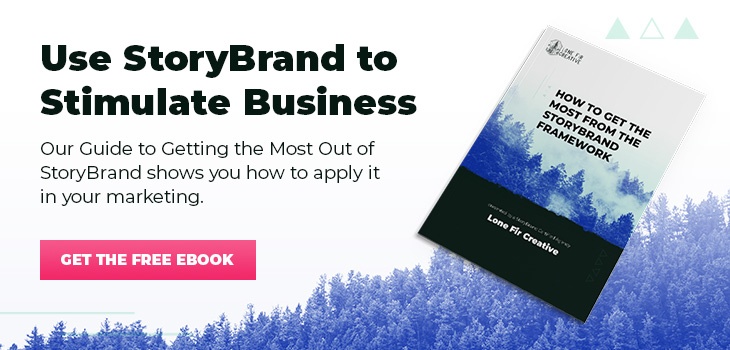Having a clear brand message can be the difference between attracting or confusing a potential customer. Take it from Donald Miller, author of the bestseller, Building a StoryBrand, and CEO of StoryBrand. He says, “If you confuse, you’ll lose.”
What good are your digital marketing efforts if your potential customers are confused about what you do? The likelihood of them converting into a customer is pretty low if they don't understand how you help them.
Make sense, right?
The dilemma is, most companies are confusing their customers and don't even know it. The good news? If you clear up your message, you'll easily stand out in your customer's eye as the perfect solution to their problem.
So how do you get there? How do you go from having a confusing and complex message to using a simple and compelling story to win customers over?
Enter — the StoryBrand Framework. This seven-part framework harnesses the power of story in your marketing material to position your brand as the obvious guide your potential customers need to achieve success. And as the cornerstone of your marketing strategy, your brand message needs to be clear, compelling and consistent. It should influence every piece of content, every headline and every bullet point you create.
If you're reading this wondering if your marketing message could use some improvement, the answer is likely yes. Luckily, you're in the right place. The rest of this article focuses on three easy steps you can take to start improving your message immediately.
And if you want to learn more about StoryBrand, check out how using story formulas and the StoryBrand Framework changed the way we work with clients.
The 3 Steps to Clarify Your Message
If you've read Building a StoryBrand, you'll be familiar with a BrandScript and how it can provide clarity to the entirety of your brand message. The thing is, developing a solid BrandScript can be a bit overwhelming for a lot of companies.
That's okay! We're here to help. After working with 100+ brands develop their BrandScript, we've come up with a few simple (yet thought-provoking) questions that will get you started in the right direction. While we love the structure and clarity of a BrandScript, these three easy questions have proven most useful as a user-friendly compass that will guide you toward creating a clear message to use in all of your marketing material.
- What does your company offer? Not only does it need to be blatantly obvious what your company provides, but it also needs to be obvious how that aligns with what your customer wants.
- How does it make your customer's life better? You need to show how you fit into your customer's story (not the other way around) and answer the questions they have as they search for products and services like yours.
- How can your customers buy your product or service? You need to hand the user a roadmap of what it looks like to do business with you. And that means clear calls to action: 'Buy Now,' 'Call Now,' 'Schedule a Meeting,' 'Start Free Trial,' etc. If prospects have taken the time to read about your products or services, make sure they know exactly what they need to do next.
As a business owner, putting yourself in the shoes of your past, present and future customers might be the most important thing you do when creating your brand message. Take some time to think through the three questions above. It will force you to look at your company and brand objectively; from the perspective of your potential customers.
Make Your Customer the Hero and Stop Drinking Your Own Kool-Aid
Some people call this “the curse of knowledge.” You’re so close to your company, products, social media messaging, and services that you can't boil it down into simple terms.
This is a problem because you only have a few seconds to pitch your customer, so you need to be able to communicate the value you bring clearly and concisely before they lose interest. This applies to anything you're communicating, no matter the marketing channel.
Right now, if I asked you to give me your "elevator pitch," what would you say? Do you think I could easily understand what you do in less than 30 seconds? If not, you might be confusing prospects and losing potential customers.
Here's a fundamental change you can make that will help you begin the process of simplifying your message: Talk less about your company and more about the solutions you provide as it relates to what the customer wants or the challenges they are facing.
In the StoryBrand Framework, this is called making your customer the hero of the story. When you make the customer the hero, you talk less about yourself and more about your character and their story.
Address the Customer's Problem
I read an article several years ago from Fast Company called Why Customer Pain Is Your Most Important Resource. It has stuck with me as one of the single most impactful ways to identify with both current customers and prospects. The article walks readers through the most critical question business leaders can ask, "Why do human beings buy anything?" The article identifies the two reasons people spend money: to “combat pain” and “pursue pleasure.” More than likely, it happens in that order since the human brain tends to address its pains and challenges before pleasures.
“So, look for the pain. Think of things that people find disturbing, frustrating, urgent or uncomfortable. Then, with the pain clearly recognized and in mind, switch gears and develop cures. Focus on healing. Let that be your guide as you try to invent a venture that will make the pain go away.”
With this in mind, clarify your brand message by clearly stating how you can solve your customer's problem, i.e., make their pain go away.
Want to learn more about why people buy? Listen to (or read!) this interview with Seth Godin from the Building a StoryBrand podcast: “5 Huge Paradigm Shifts That Will Change the Way You Do Marketing.”
Apply Your Brand Message to...Everything
Creating a clear message doesn't stop after this one exercise. It's a filter that should provide a gut check for every piece of content your company publishes, including your entire website (see how that plays out in these StoryBrand website examples).
And as your company evolves, so will your messaging. When you review your company's growth plan and strategy, make sure you still have a clear message that communicates your current products and services in a way that is relevant to your target audience.
👉 To keep learning about how a story-based framework can create effective messaging, check out How the StoryBrand BrandScript Helps Any Product Sell Itself.









